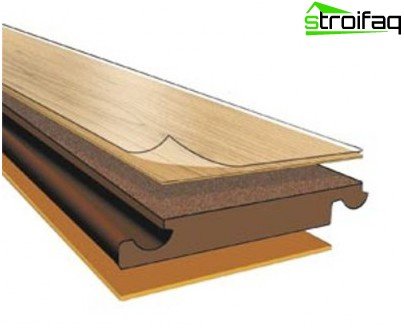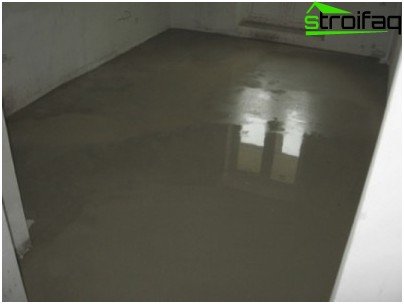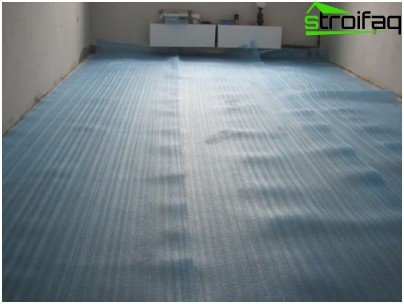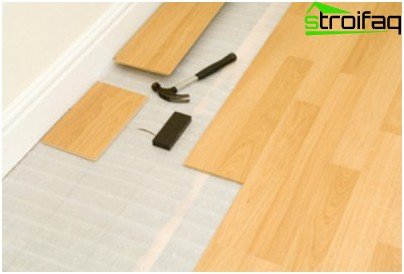Laminate flooring
The choice of floor material is always quite acute. This is due to the fact that the modern market of finishing materials offers a fairly wide assortment, and manufacturers seek to find new solutions that successfully combine practicality, functionality and a reasonable price. One of these solutions was a laminate a few years ago. So, the device of the laminate is quite light, and the performance of the material does not leave indifferent.
It is worth noting that the laminate has an excellent appearance. It looks no worse than a natural tree, and its decorative coating allows you to simulate a variety of materials. As you know, the laminate is divided into several types. They differ not only in their characteristics, but also in the structure of the board..
Content
- The “device” of the laminate board
- The base of the board is the key to strength
- Stabilizing layer – guarantee of rigidity
- Decorative layer – a design issue
- Protective layer – a reliable barrier
The “device” of the laminate board
Laminate board is a kind of “pie”, the filling of which affects the quality of the finished product. So, in this flooring it is customary to distinguish several layers:
- board base;
- its stabilizing layer;
- aesthetic decorative layer that determines the appearance of the floor;
- protective covering.

Laminate Layers
The base of the board is the key to strength
The base can be made of several materials: MDF or HDF. Using MDF allows you to get a standard floor covering with average strength, resistance to deformation when laying a laminate. The use of HDF as a basis contributes to the production of laminate boards with higher strength characteristics.
Stabilizing layer – guarantee of rigidity
The thickness of this layer is extremely small – about 0.1-0.2 mm, but its role in ensuring the quality of the facing material for the floor is quite large.
A stabilization layer is made of paper or plastic impregnated with a special composition. Its main function is to stiffen the material. It is this property that allows laminate boards to be resistant to temperature extremes, high humidity and heavy loads..
Decorative layer – a design issue
The name of this layer of laminate is already hidden its main purpose. He is responsible for the appearance of the material, its attractiveness. It is the decorative layer that gives it this or that pattern, texture. It’s no secret that the vast majority of consumers acquire flooring, based on its appearance, choosing the most suitable option for the interior.
Protective layer – a reliable barrier
The sheeting provides durability and wear resistance. Obviously, without such a coating, the decorative layer would wear out in a very short time. This layer is a polymer coating that is transparent so that the decorative coating pattern is clearly visible..
So, traditionally, a laminate board consists of four layers, however, its arrangement can be somewhat more complicated and have additional layers. This is most often the case for materials used under heavy loads..
It is worth noting that not only laminate boards have layers. Thus, the installation of laminate floors is also carried out in layers.
Laminate flooring
High-quality flooring involves all the necessary work in strict sequence.
Firstly, the previous floor covering is removed – linoleum, fiberboard or carpet. Secondly, they begin to level the floor surface. At this stage, it eliminates all cracks, chips and bumps. In the presence of large differences in height, a cement-sand screed is arranged. It will be the first layer in the “pie” of the laminate floor.

The leveling cement-sand screed under the laminate is most often performed before laying, it forms the necessary conditions for the installation of flooring
After drying, the screed is checked for differences using the building level. If the surface quality is poor, you can use a self-leveling mixture. After it hardens, you can proceed to the device of the next layer.
To provide additional comfort and durability of a laminate floor, it is necessary to take care of laying a moisture- and vapor-tight layer. As a rule, its thickness is 2-3 mm. The selected material is spread over the floor surface and trimmed around the perimeter of the room. All existing joints are glued with special adhesive tape. The need for laying vapor barrier material arises when installing a laminate floor on a concrete surface.
Then the noise absorbing substrate is laid. In addition to its direct function, it contributes to smoothing irregularities and is a depreciation layer. Today, there is a choice between a special substrate (professional), cork or foamed polyethylene. As a rule, manufacturers market flooring already with a backing..

Noise-absorbing substrate under the laminate simultaneously with direct work compensates for the load and serves as an additional leveling layer
After that, you can proceed directly to laying the laminate boards – this will be the final layer when installing the floor. Installation of the finish layer of the laminate is carried out in a “floating” way, that is, the material is not attached to the base. The boards are interconnected in a castle way. In this case, the laminate panels are connected tight enough so as not to form any gaps.
Particular attention should be paid to the formation of gaps near the walls. They are performed using pre-prepared spacers. Their use allows you to leave at the junction of the laminate and the wall a sufficient distance to expand the flooring. If you ignore this nuance, then a situation may arise when the finished floor simply “swells”.

To unite the slats, a compensation bar is necessary, “hammering” on the laminate is unacceptable
The device of the laminate floor is completed by the installation of a floor plinth. It must be ensured that it does not interfere with the outflow of moisture from the laid screed.
If you are planning a floor heating device, it is recommended that you opt for a water or infrared film version. It is these warm floors that do not allow strong and sharp heating of the floor covering, which can lead to a violation of its integrity.
Thus, the installation of a laminate floor requires a mandatory consideration of the operational characteristics of the material and careful observance of the sequence necessary for the performance of work. As a result, you will get a durable, high-quality floor covering that can last for many years, which will be pleasing to the eye and will become a decoration of the interior of your home.






